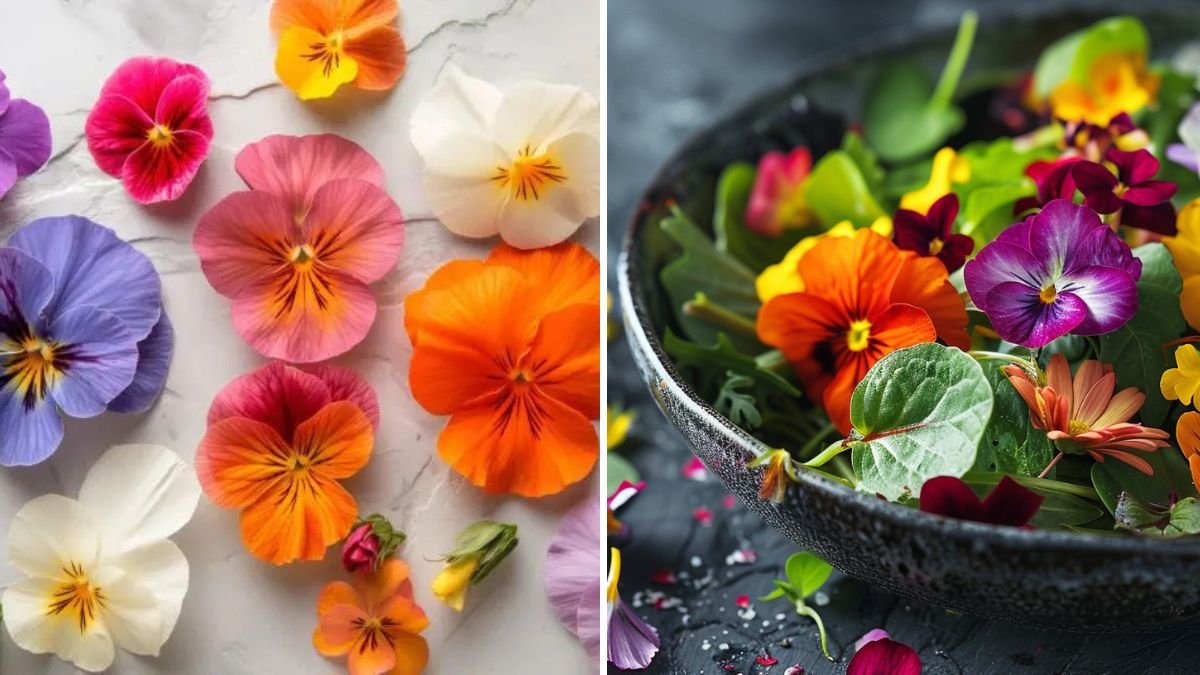Flowers are no longer confined to gardens or decorative vases—they are increasingly finding their way into kitchens as edible garnishes. Not only do they add vibrant colors and aesthetic appeal to dishes, but many flowers also contribute subtle flavors, aromas, and nutritional benefits. Using edible flowers in culinary creations can transform simple meals into visually stunning, gourmet experiences. This article explores five flowers that make the best edible garnishes, detailing their flavors, culinary uses, growing tips, and safety considerations for incorporating them into your meals.
Why Use Edible Flowers as Garnishes?
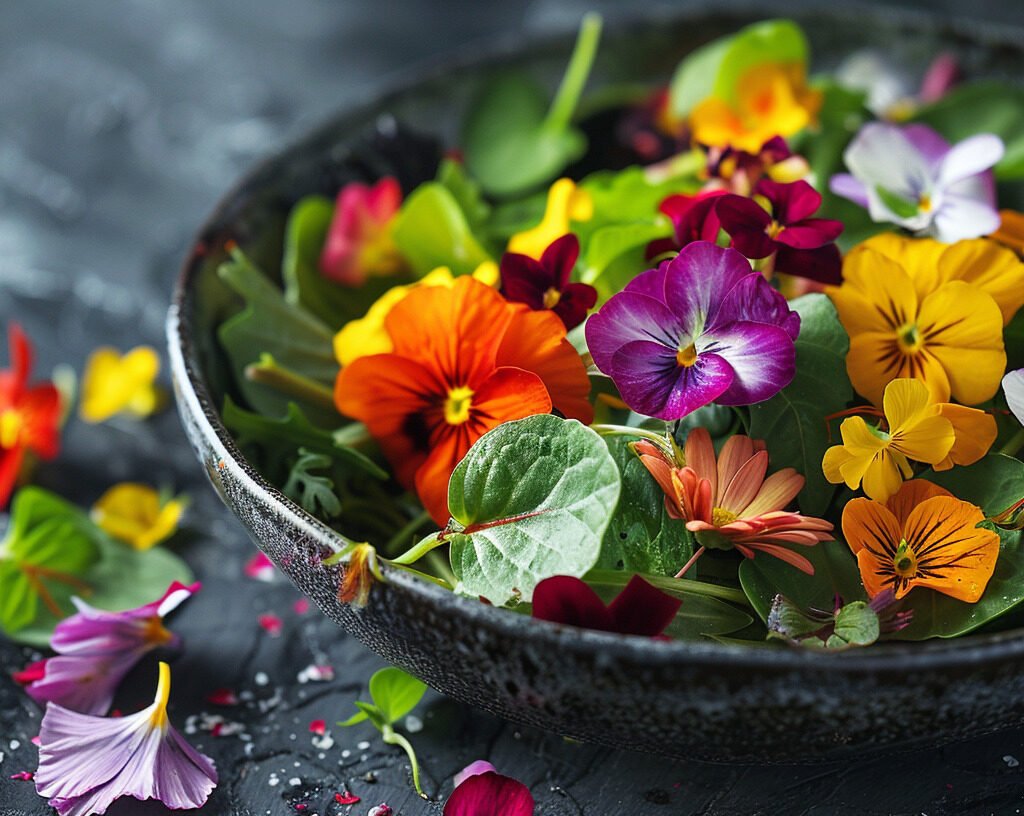
Adding flowers to food is both an art and a science. Edible flowers provide several advantages:
- Visual Appeal: Flowers can instantly elevate the presentation of any dish, making it more inviting and sophisticated.
- Flavor Enhancement: Many edible flowers offer subtle flavors ranging from sweet and citrusy to peppery or herbaceous.
- Aromatic Benefits: Some flowers release delicate fragrances that enhance the sensory experience of dining.
- Nutritional Boost: Certain edible flowers contain antioxidants, vitamins, and minerals.
- Culinary Creativity: Chefs and home cooks can experiment with plating, color combinations, and flavor pairings.
Safety Tip: Only use flowers specifically known to be edible. Avoid flowers treated with pesticides or chemicals, and never consume ornamental flowers that haven’t been verified as safe.
1. Nasturtiums (Tropaeolum majus)
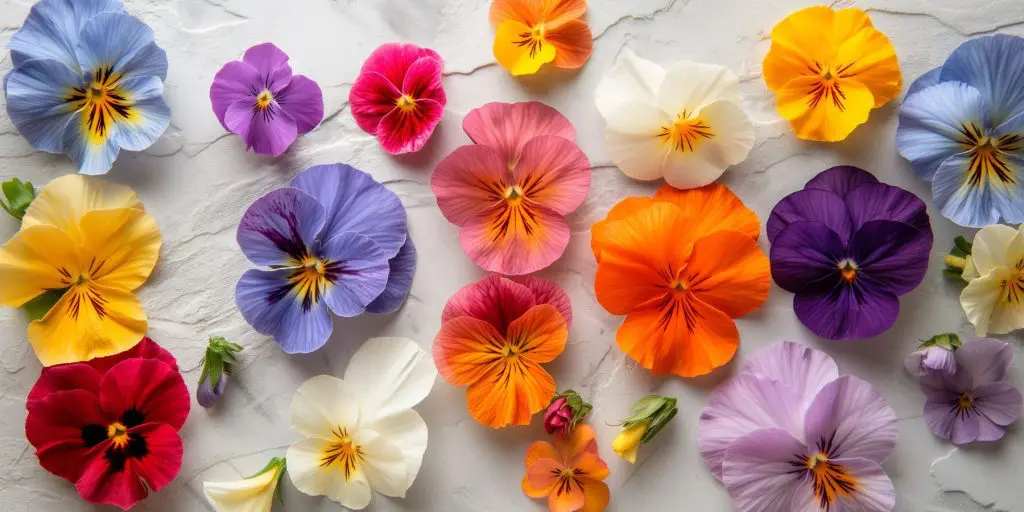
Flavor Profile:
- Peppery, slightly spicy, similar to arugula or mustard greens.
- Leaves and flowers are both edible, though flowers are preferred for garnishing.
Culinary Uses:
- Sprinkle bright orange, red, or yellow petals over salads for color and flavor.
- Use as a topping on cream cheeses, canapés, and savory tarts.
- Freeze petals in ice cubes for use in beverages and cocktails.
Growing Tips:
- Thrive in full sun with well-draining soil.
- Grow quickly from seeds sown in spring.
- Deadhead regularly to prolong flowering and garnish availability.
Fun Fact: Nasturtiums attract pollinators like bees and butterflies, adding an ecological benefit to gardens.
2. Pansies (Viola × wittrockiana)
Flavor Profile:
- Mild, slightly grassy, and sometimes honey-like.
- Petals are the primary edible portion, while leaves are less commonly consumed.
Culinary Uses:
- Decorate desserts, cupcakes, and cookies with vibrant purple, yellow, and white petals.
- Add to salads for a touch of color and subtle flavor.
- Candied pansy petals can be used for elaborate cake decoration.
Growing Tips:
- Prefer cooler temperatures and partial sunlight.
- Sow seeds indoors 8–10 weeks before the last frost or purchase seedlings.
- Deadhead spent blooms to encourage continuous flowering.
Fun Fact: Pansies are edible and safe to eat raw, making them perfect for fresh salads and cold dishes.
3. Calendula (Calendula officinalis)
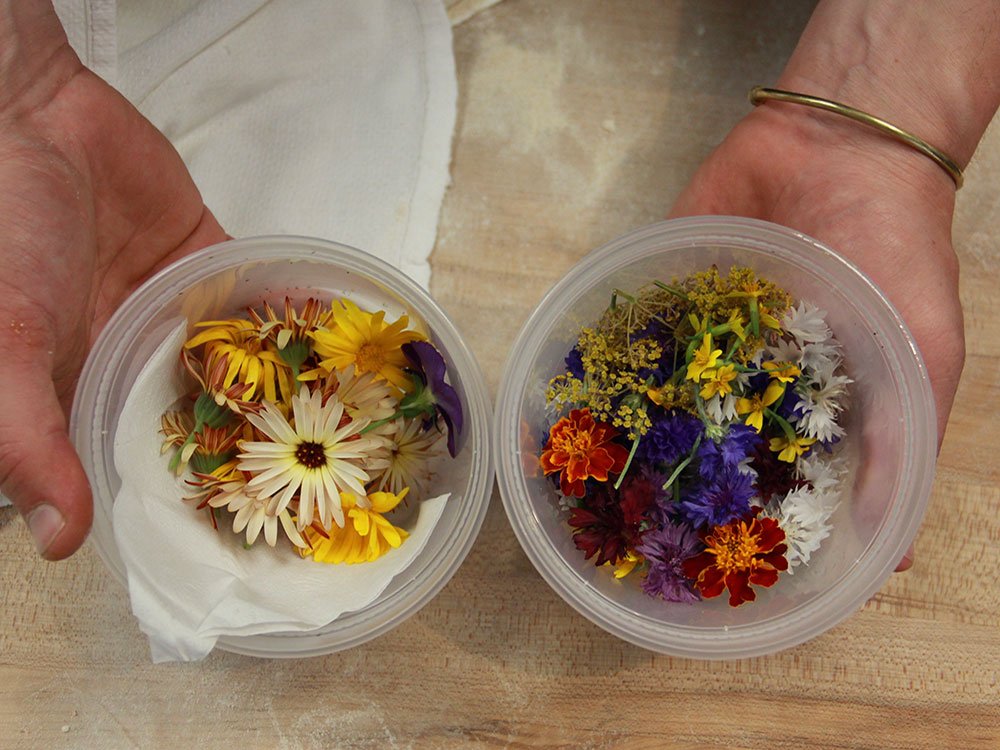
Flavor Profile:
- Slightly tangy, with a mild peppery or saffron-like taste.
- Often referred to as “pot marigold,” calendula petals can be used as a natural food colorant.
Culinary Uses:
- Sprinkle petals over soups, risottos, and grain salads for visual and flavor enhancement.
- Infuse petals in butter, oil, or vinegar for cooking.
- Use as a colorful garnish on deviled eggs, cheese platters, and roasted vegetables.
Growing Tips:
- Prefers full sun and moderately fertile, well-draining soil.
- Sow seeds directly outdoors after the last frost.
- Deadhead flowers regularly to prolong blooming and garnish availability.
Fun Fact: Calendula petals are often called “poor man’s saffron” due to their bright color and culinary versatility.
4. Borage (Borago officinalis)
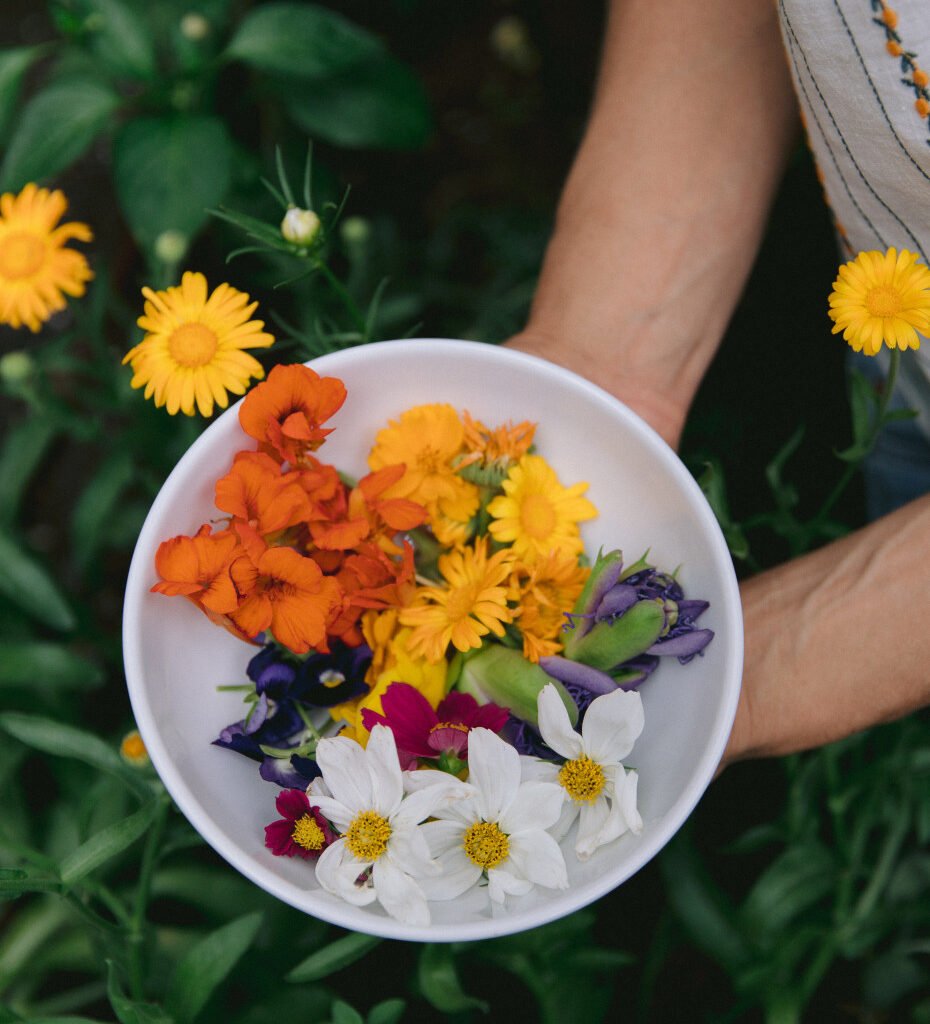
Flavor Profile:
- Mild cucumber-like taste, fresh and slightly sweet.
- Both flowers and leaves are edible, but flowers are particularly popular as garnishes.
Culinary Uses:
- Add blue, star-shaped petals to cocktails, lemonade, or iced tea.
- Garnish salads, soups, and seafood dishes for visual appeal.
- Freeze in ice cubes for an elegant touch in beverages.
Growing Tips:
- Grow in full sun with well-draining soil.
- Self-seeds easily, so allow some flowers to mature and drop seeds.
- Remove old or wilted flowers to encourage continuous blooming.
Fun Fact: Borage flowers are edible for humans and also highly attractive to bees, supporting pollinator populations in the garden.
5. Violas (Viola odorata)
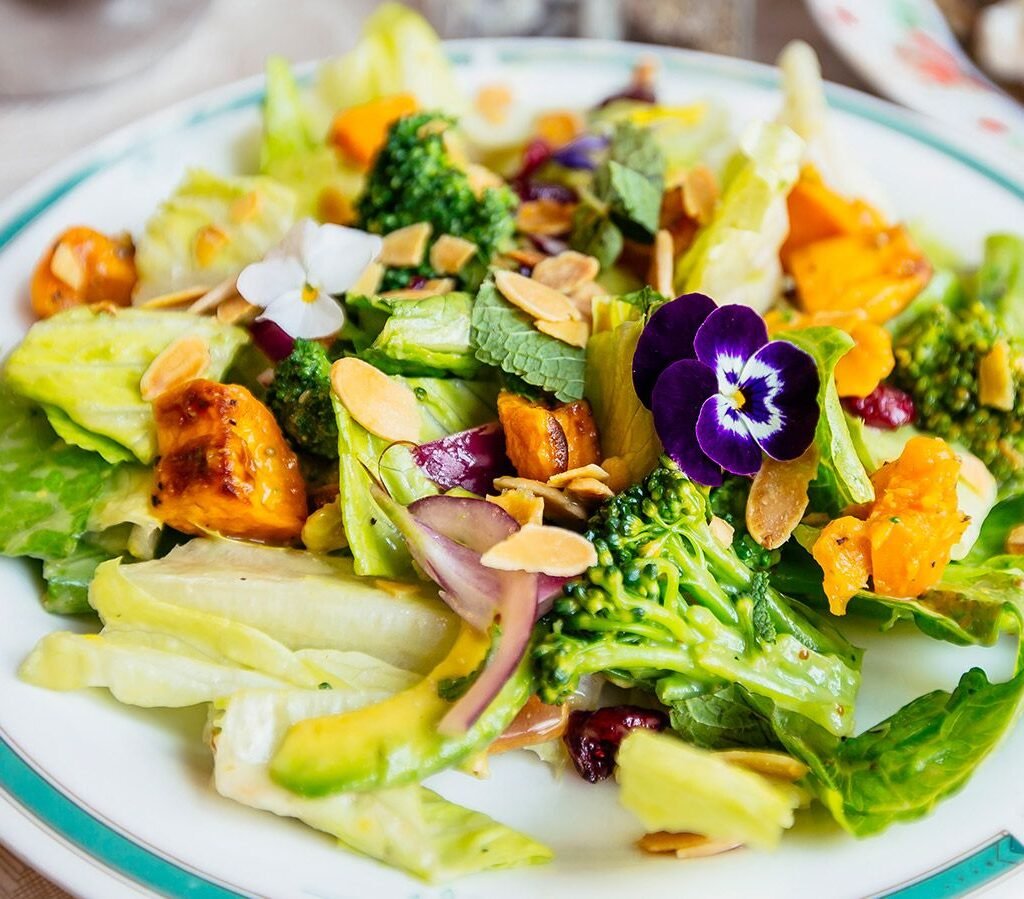
Flavor Profile:
- Sweet, floral, and delicate, often compared to honey or violets.
- Both petals and leaves are edible, though petals are commonly used for garnishing.
Culinary Uses:
- Decorate desserts, pastries, and chocolates with vibrant purple or white petals.
- Infuse sugar or syrups with violets for flavoring baked goods and beverages.
- Add a fragrant touch to spring salads or fruit platters.
Growing Tips:
- Prefers cooler weather and partial shade.
- Plant in well-draining soil with consistent moisture.
- Deadhead regularly to promote extended flowering.
Fun Fact: Viola flowers have been used historically in syrups and candied confections for centuries, making them a classic edible garnish.
Step-by-Step Guide to Using Flowers as Garnishes
- Harvesting: Pick flowers in the morning when petals are fresh and turgid. Avoid flowers exposed to pesticides.
- Cleaning: Rinse gently with cool water and pat dry with a paper towel.
- Trimming: Remove stems, sepals, and any damaged petals for a neat appearance.
- Storage: Use immediately for freshness or store in airtight containers in the refrigerator for up to 2 days.
- Presentation: Place flowers delicately on dishes just before serving to preserve color, texture, and flavor.
Tip: Combining flowers with complementary herbs, edible leaves, or microgreens can enhance both flavor and visual appeal.
Safety Considerations for Edible Flowers
- Ensure flowers are 100% edible; not all garden blooms are safe to consume.
- Avoid flowers treated with chemical pesticides or fertilizers.
- Introduce new edible flowers gradually to test for allergic reactions.
- If harvesting from the wild, verify the plant species and avoid contaminated areas.
Advantages of Using Edible Flowers as Garnishes
- Enhanced Culinary Presentation: Makes dishes more visually appealing for professional or home settings.
- Flavor Innovation: Introduces subtle, unique flavors that complement a wide variety of dishes.
- Health Benefits: Some flowers contain antioxidants and vitamins that provide added nutritional value.
- Sustainability: Encourages the use of home-grown flowers rather than commercially packaged decorations.
- Creative Flexibility: Offers endless opportunities for experimentation in plating, color combinations, and seasonal menus.
Conclusion
Edible flowers are a delightful addition to any kitchen, offering both visual appeal and subtle flavor enhancements. Nasturtiums, pansies, calendula, borage, and violas stand out as some of the best flowers for garnishing, thanks to their vibrant colors, unique flavors, and ease of cultivation. By understanding how to grow, harvest, clean, and store these flowers, home cooks and chefs alike can elevate their culinary creations while embracing sustainable and creative practices. Whether decorating salads, desserts, beverages, or main courses, edible flowers provide a sophisticated touch that transforms ordinary dishes into extraordinary experiences. With proper care and selection, these blooms can bring beauty, flavor, and elegance to the dining table year after year.
